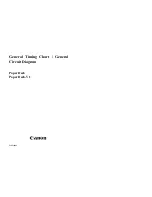
2. Moving Down the Lifter
a. Condition 1
•
The paper deck door is opened so that
➝
the door open signal (STD0) is ‘0’.
•
The lifter lower limit switch (SW11) is OFF
so that
➝
the lifter lower limit signal (
) is ‘1’.
The above condition causes the combination
circuit to generate the following outputs:
up/down switching signal=0 and
paper deck motor ON signal=0,
thereby, moving down the lifter.
b. Condition 2
•
When a jam occurs, the output from the
microprocessor (Q115) on the DC con-
troller PCB (lifter up/down control signal)
changes from ‘0’ to ‘1’.
This condition causes the up/down switch-
ing signal to go ‘1’, causing the lifter to
move down. At this time, the lifter will not
move down to the lower limit but will stop at
a point where the top surface of the paper
stack has lowered a maximum of about
12.5 mm.
STLLD
3. OPERATIONS AND TIMING
COPYRIGHT © 1996 CANON INC.
CANON NP6085 REV.0 JULY 1996 PRINTED IN JAPAN (IMPRIME AU JAPON)
3-88
Combination
circuit
Lifter up/down control signal (DKDOWN)
Lifter position signal (SLTP) J501-B2
Lifter lower limit signal (STLLD) J501-A10
Door open signal (STDO) J501-A8
5VR
NC
Paper deck
upper limit
switch
Paper deck
lifter position
switch
Paper deck
lifter lower
limit switch
Paper deck
door open/
close detected
switch
Paper deck motor
DC controller PCB
24VU
24VU
24VU
Motor drive circuit
Overcurrent
detection
Paper deck motor ON sigal (STLMON)
UP/DOWN switch signal (STLUD)
SW10
Q17
SW11
SW12
Side tray driver PCB
M4
(Q115)
Microprocessor
(slave)
Lifter ON control signal (DKON)
J502-A10
J502-A9
Low:up
high:Down
J501-B7
J501-B8
Figure 3-405
















































